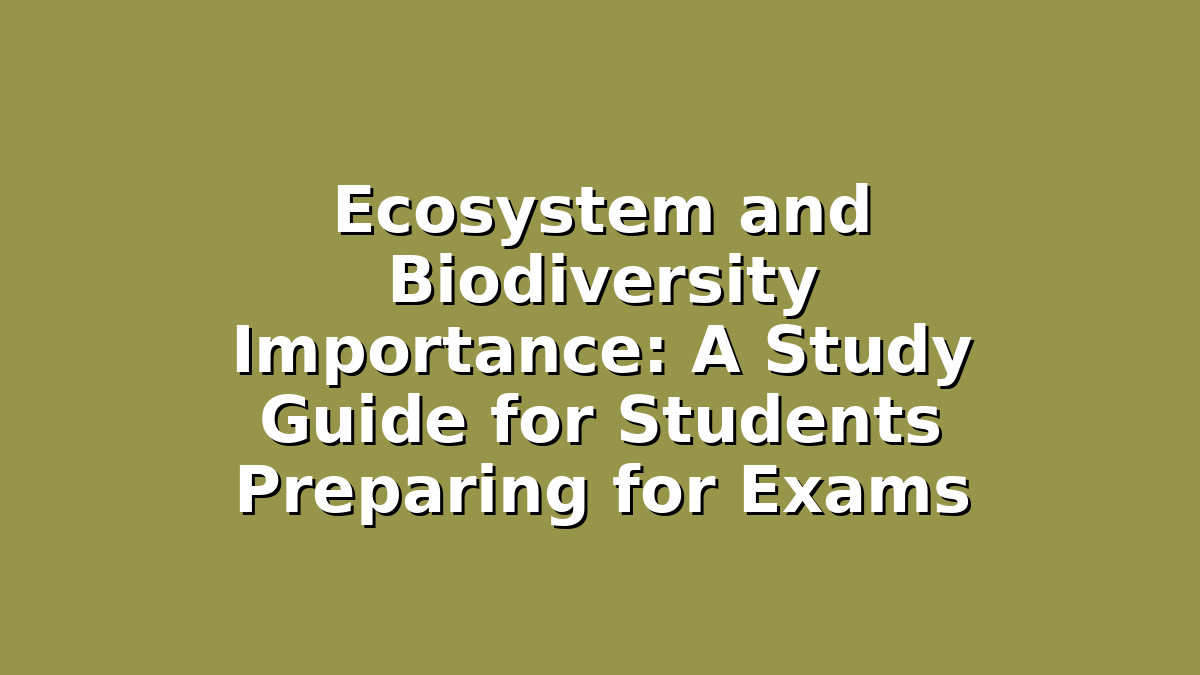Understanding ecosystems and biodiversity is essential not only for students aiming to excel in biology exams but also for anyone interested in the natural world. These topics frequently appear in science syllabuses worldwide, and a solid grasp can boost your exam performance while deepening your appreciation for the environment. This article will guide you through the importance of ecosystems and biodiversity, alongside effective study tips tailored for students preparing for exams.
Introduction: Why Learn About Ecosystems and Biodiversity?
Ecosystems are communities of living organisms interacting with each other and their physical environment. Biodiversity refers to the variety of life forms within these ecosystems, including plants, animals, fungi, and microorganisms. Together, they maintain the balance of nature and support life on Earth.
For students, understanding these concepts is crucial because:
– They are central to biology and environmental science curricula.
– They highlight the relationship between humans and nature.
– They provide context for current global challenges like climate change and conservation efforts.
By mastering these topics, you’ll be well-equipped to answer exam questions, write essays, and apply knowledge in real-life scenarios.
Section 1: Grasping the Basics – Key Concepts and Definitions
Before diving into complex details, ensure you have a strong foundation by memorizing and understanding key terms:
– Ecosystem: A system formed by the interaction of a community of organisms with their physical environment.
– Biodiversity: The variety and variability of life forms within an ecosystem, including genetic, species, and ecosystem diversity.
– Producers, Consumers, and Decomposers: Different roles organisms play within an ecosystem.
– Food Web and Food Chain: The interconnected feeding relationships among species.
– Habitat: The natural environment where a species lives.
Study Tip: Use flashcards to memorize definitions and key terms. Writing the words on one side and their meanings on the other can enhance recall. Regularly testing yourself helps reinforce memory, especially when done over spaced intervals.
Encouragement: Don’t rush through definitions! A clear understanding of foundational vocabulary makes it easier to comprehend exam questions and write concise answers.
Section 2: Understanding Ecosystem Functions and Biodiversity Importance
Ecosystems provide essential services that sustain life:
– Provisioning Services: Supply of food, water, timber, and medicine.
– Regulating Services: Climate regulation, water purification, and pollination.
– Supporting Services: Nutrient cycling and soil formation.
– Cultural Services: Recreational, spiritual, and educational benefits.
Biodiversity plays a vital role in ensuring ecosystem resilience and productivity. A diverse ecosystem can better withstand environmental stress and recover from disturbances such as natural disasters or human activities.
Study Tip: Create diagrams or mind maps linking ecosystem services to biodiversity. Visual aids help you organize information and make connections, which boosts deeper understanding and retention.
Encouragement: Try to relate these concepts to real-life examples, such as local parks or nature reserves. Connecting textbook information to your surroundings makes learning more meaningful and engaging.
Section 3: Applying Knowledge – Exam Preparation and Study Strategies
When preparing for exams, it’s important to practice applying your knowledge effectively:
– Practice Past Papers: Work on previous exam questions related to ecosystems and biodiversity. This helps familiarize you with question formats and common themes.
– Use Case Studies: Many exams include questions based on specific ecosystems or endangered species. Study case studies to understand real-world applications.
– Explain Concepts Aloud: Teaching material to a friend or recording yourself explaining key topics can reveal gaps in understanding and boost confidence.
– Time Management: Allocate regular study sessions focusing on ecosystem topics to avoid last-minute cramming.
Study Tip: Use the “Feynman Technique” — pick a topic (e.g., the importance of biodiversity), write out an explanation as if teaching someone with no background, identify gaps, and review the material to fill those gaps.
Encouragement: Remember, consistent revision is more effective than intense, last-minute studying. Celebrate small victories as you master each concept—it all adds up!
Conclusion: Your Role in Protecting Ecosystems and Biodiversity
Studying ecosystems and biodiversity is not just about passing exams; it’s about understanding how life on Earth is interconnected and how human actions impact natural balance. As a student, you have the power to become an informed advocate for the environment.
By mastering the key concepts, appreciating the importance of biodiversity, and practicing effective study techniques, you will not only succeed in your exams but also develop a lifelong respect for nature.
Stay curious, stay motivated, and remember that every bit of effort you put into learning today helps create a better tomorrow—for you, your community, and the planet.

Responses